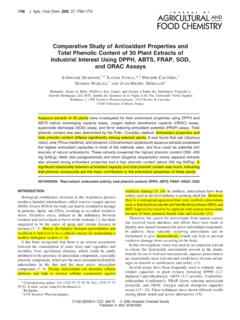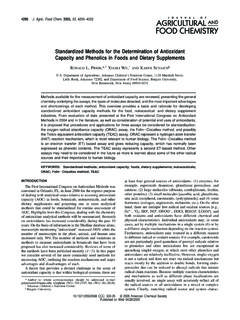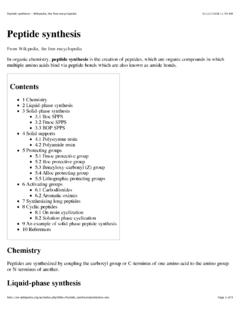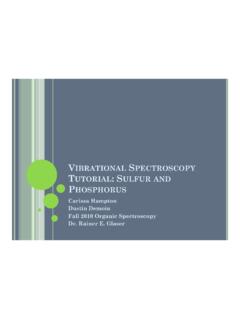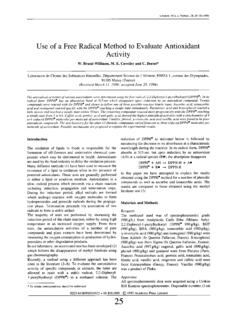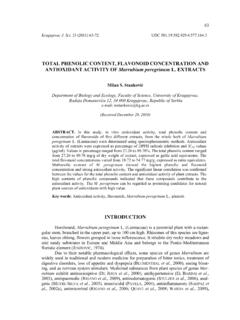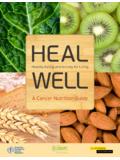Transcription of Standardized Methods for the Determination of …
1 4290 J. Agric. Food Chem. 2005, 53, 4290 4302. Standardized Methods for the Determination of Antioxidant Capacity and Phenolics in Foods and Dietary Supplements RONALD L. PRIOR,*, XIANLI WU, AND KAREN SCHAICH . Department of Agriculture, Arkansas Children's Nutrition Center, 1120 Marshall Street, Little Rock, Arkansas 72202, and Department of Food Science, Rutgers University, New Brunswick, New Jersey 08903-0231. Methods available for the measurement of antioxidant capacity are reviewed, presenting the general chemistry underlying the assays, the types of molecules detected, and the most important advantages and shortcomings of each method. This overview provides a basis and rationale for developing Standardized antioxidant capacity Methods for the food, nutraceutical, and dietary supplement industries. From evaluation of data presented at the First International Congress on Antioxidant Methods in 2004 and in the literature, as well as consideration of potential end uses of antioxidants , it is proposed that procedures and applications for three assays be considered for standardization: the oxygen radical absorbance capacity (ORAC) assay, the Folin-Ciocalteu method, and possibly the Trolox equivalent antioxidant capacity (TEAC) assay.
2 ORAC represent a hydrogen atom transfer (HAT) reaction mechanism, which is most relevant to human biology. The Folin-Ciocalteu method is an electron transfer (ET) based assay and gives reducing capacity, which has normally been expressed as phenolic contents. The TEAC assay represents a second ET-based method. Other assays may need to be considered in the future as more is learned about some of the other radical sources and their importance to human biology. KEYWORDS: Standardized Methods ; antioxidant capacity; foods, dietary supplements; nutraceuticals;. ORAC; Folin-Ciocalteu method; TEAC. INTRODUCTION at least four general sources of antioxidants : (1) enzymes, for The First International Congress on Antioxidant Methods was example, superoxide dismutase, glutathione peroxidase, and convened in Orlando, FL, in June 2004 for the express purpose catalase; (2) large molecules (albumin, ceruloplasmin, ferritin, of dealing with analytical issues relative to assessing antioxidant other proteins); (3) small molecules [ascorbic acid, glutathione, capacity (AOC) in foods, botanicals, nutraceuticals, and other uric acid, tocopherol, carotenoids, (poly)phenols]; and (4) some dietary supplements and proposing one or more analytical hormones (estrogen, angiotensin, melatonin, etc.)
3 On the other Methods that could be Standardized for routine assessment of hand, there are multiple free radical and oxidant sources [ , AOC. Highlights from this Congress, dealing with the chemistry O2 -, 1O2, HO , NO , ONOO-, HOCl, RO(O) , LO(O) ], and of antioxidant analytical Methods will be summarized. Research both oxidants and antioxidants have different chemical and on antioxidants has increased considerably during the past 10 physical characteristics. Individual antioxidants may, in some years. On the basis of information in the Medline database alone, cases, act by multiple mechanisms in a single system (6) or by manuscripts mentioning antioxidant increased 340% while the a different single mechanism depending on the reaction system. number of manuscripts in the plant, animal, and human area Furthermore, antioxidants may respond in a different manner increased only 39%.The number of Methods and variations in to different radical or oxidant sources.
4 For example, carotenoids Methods to measure antioxidants in botanicals that have been are not particularly good quenchers of peroxyl radicals relative proposed has also increased considerably. Reviews of some of to phenolics and other antioxidants but are exceptional in the Methods have been published recently (1-5). In this paper quenching singlet oxygen, at which most other phenolics and we consider several of the more commonly used Methods for antioxidants are relatively ineffective. However, singlet oxygen measuring AOC, outlining the reaction mechanisms and major is not a radical and does not react via radical mechanisms but advantages and disadvantages of each. reacts mostly by the addition to double bonds, forming endo- A factor that provides a distinct challenge in the assay of peroxides that can be reduced to alkoxyl radicals that initiate antioxidant capacity is that within biological systems, there are radical chain reactions. Because multiple reaction characteristics and mechanisms as well as different phase localizations are * Author to whom correspondence should be addressed [e-mail usually involved, no single assay will accurately reflect all of telephone (501) 354-2747; fax (501) 364-2818].
5 Arkansas Children's Nutrition Center. the radical sources or all antioxidants in a mixed or complex Rutgers University. system. Clearly, matching radical source and system charac- CCC: $ 2005 American Chemical Society Published on Web 04/26/2005. Standardized Methods for Antioxidant Capacity Determination J. Agric. Food Chem., Vol. 53, No. 10, 2005 4291. teristics to antioxidant reaction mechanisms is critical in the X + AH f XH + A (1). selection of appropriate AOC assay Methods , as is consideration of the end use of the results. It must be appreciated at the outset Hence, many scientists feel these are most relevant to reactions that there is no simple universal method by which AOC can be where antioxidants typically act. Relative reactivity in HAT. measured accurately and quantitatively. Methods is determined by the BDE of the H-donating group in Why Do We Need a Standardized AOC Method? Although the potential antioxidant, dominating for compounds with BDE.
6 It may seem intuitive, one might question why we need of -10 kcal/mol and ionization potential ( IP) of < -36. Standardized analytical Methods of AOC. Agreement on stan- kcal/mol (7). Antioxidant reactivity or capacity measurements dardized test Methods allows for (1) guidance for appropriate are based on competition kinetics. HAT reactions are solvent application of assays, (2) meaningful comparisons of foods or and pH independent and are usually quite rapid, typically commercial products, (3) a means to control variation within completed in seconds to minutes. The presence of reducing or between products, and (4) provision of quality standards for agents, including metals, is a complication in HAT assays and regulatory issues and health claims. Too many analytical can lead to erroneously high apparent reactivity. Methods result in inconsistent results, inappropriate application SET-based Methods detect the ability of a potential antioxidant and interpretation of assays, and improper specification of AOC.
7 To transfer one electron to reduce any compound, including Without some agreement on standards for quantities and units, metals, carbonyls, and radicals (7): marketing of botanicals and associated trade becomes haphazard, science becomes unscientific , and technological development X + AH f X- + AH + (1). of nutraceuticals is handicapped. H2 O. Factors for Consideration in Method Selection and AH + 798 A + H3O+ (2). Development. In the selection of any method for standardiza- tion, a first consideration is that the method has been used for X- + H3O+ f XH + H2O (3). a sufficient amount of time and in a number of different laboratories such that the strengths and weaknesses of the assay have become apparent and some time has been spent in dealing M(III) + AH f AH+ + M(II) (4). with these issues. This is not to say that newer Methods may SET and HAT mechanisms almost always occur together in all not potentially be as good or better, but use over time will samples, with the balance determined by antioxidant structure generally point this out.
8 A Standardized method for AOC should and pH. Relative reactivity in SET Methods is based primarily meet the following ideal requirements: (1) measures chem- on deprotonation (8) and IP (7) of the reactive functional group, istry actually occurring in potential application(s); (2) utilizes so SET reactions are pH dependent. In general, IP values a biologically relevant radical source; (3) simple; (4) uses a decrease with increasing pH, reflecting increased electron- method with a defined endpoint and chemical mechanism; (5) donating capacity with deprotonation. The antioxidant mecha- instrumentation is readily available; (6) good within-run and nism is predominantly SET for compounds with a IP of > -45. between-day reproducibility; (7) adaptable for assay of both kcal/mol. A correlation between redox potential and SET. hydrophilic and lipophilic antioxidants and use of different Methods has been suggested (2) but not consistently demon- radical sources; (8) adaptable to high-throughput analysis for strated.
9 Routine quality control analyses. SET reactions are usually slow and can require long times Performance characteristics that should be considered in the to reach completion, so antioxidant capacity calculations are standardization of an assay include (a) analytical range, (b) based on percent decrease in product rather than kinetics. When recovery, (c) repeatability, (d) reproducibility, and (e) recogni- AH + has a sufficient lifetime, secondary reactions become a tion of interfering substances. significant interference in assays and can even lead to toxicity or mutagenicity in vivo (9). SET Methods are very sensitive to REACTION MECHANISMS ascorbic acid and uric acid, which are important in maintaining Differentiation between Hydrogen Atom Transfer (HAT) plasma redox tone, and reducing polyphenols are also detected. and Single Electron Transfer (SET). antioxidants can deac- Importantly, trace components and contaminants (particularly tivate radicals by two major mechanisms, HAT and SET.)
10 The metals) interfere with SET Methods and can account for high end result is the same, regardless of mechanism, but kinetics variability and poor reproducibility and consistency of results. and potential for side reactions differ. Proton-coupled electron transfer and HAT reactions may occur in parallel, and the CHARACTERISTICS OF CANDIDATE AOC Methods . mechanism dominating in a given system will be determined AOC Methods Utilizing HAT Reaction Mechanisms. A. by antioxidant structure and properties, solubility and partition number of assays have been developed for the detection of both coefficient, and system solvent. Bond dissociation energy (BDE) general and specific antioxidant action. Of these, oxygen radical and ionization potential (IP) are two major factors that determine absorbance capacity (ORAC), and total radical-trapping anti- the mechanism and the efficacy of antioxidants (7). There is oxidant parameter (TRAP) (and some of its variants) meet the often confusion in the literature and mistaken attribution of most requirements for screening assays outlined above and may reaction mechanisms.
